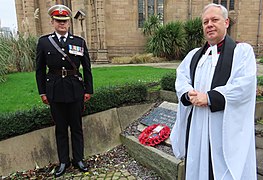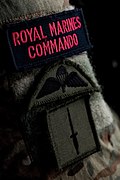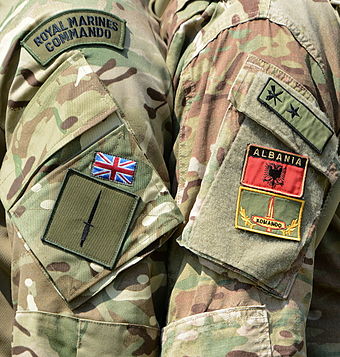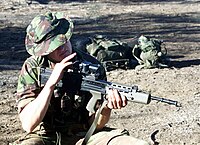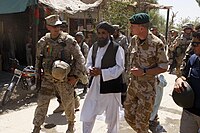
A military uniform is a standardised dress worn by members of the armed forces and paramilitaries of various nations.

Mess dress uniform is the most formal type of evening-wear uniform used by military personnel, police personnel, and other uniformed services members. It frequently consists of a mess jacket, trousers, white dress shirt and a black bow tie, along with orders and medals insignia. Design may depend on regiment or service branch, e.g. army, navy, air force, marines, etc. In modern Western dress codes, mess dress uniform is the supplementary alternative equivalent to the civilian black tie for evening wear. Mess dress uniforms are typically less formal than full dress uniform, but more formal than service dress uniform.

The pith helmet, also known as the safari helmet, salacot, sola topee, sun helmet, topee, and topi is a lightweight cloth-covered helmet made of sholapith. The pith helmet originates from the Spanish military adaptation of the native salakot headgear of the Philippines.

Imperial Japanese Army uniforms tended to reflect the uniforms of those countries who were the principal advisors to the Imperial Japanese Army at the time.

Full dress uniform, also known as a ceremonial dress uniform or parade dress uniform, is the most formal type of uniforms used by military, police, fire and other public uniformed services for official parades, ceremonies, and receptions, including private ones such as marriages and funerals. Full dress uniforms typically include full-size orders and medals insignia. Styles tend to originate from 19th century uniforms, although the 20th century saw the adoption of mess dress-styled full-dress uniforms. Designs may depend on regiment or service branch. In Western dress codes, full dress uniform is a permitted supplementary alternative equivalent to the civilian white tie for evening wear or morning dress for day wear – sometimes collectively called full dress – although military uniforms are the same for day and evening wear. As such, full dress uniform is the most formal uniform, followed by the mess dress uniform.
The uniforms of the Canadian Armed Forces are the official dress worn by members of Canada's military while on duty.
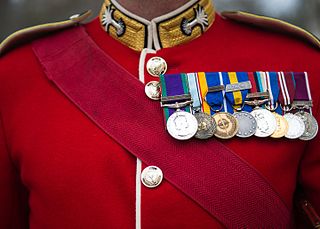
Red coat, also referred to as redcoat or scarlet tunic, is a military garment formerly much used by British infantry servicemen, so customarily that the term became a common synecdoche for the servicemen themselves.
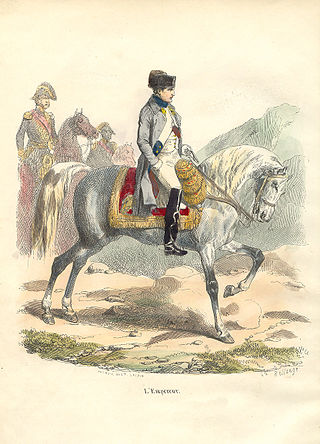
The uniforms of La Grande Armée, the army of Napoleon I, are described in this article.

The uniforms of the British Army currently exist in twelve categories ranging from ceremonial uniforms to combat dress. Uniforms in the British Army are specific to the regiment to which a soldier belongs. Full dress presents the most differentiation between units, and there are fewer regimental distinctions between ceremonial dress, service dress, barrack dress and combat dress, though a level of regimental distinction runs throughout.

Service dress uniform is the informal type of uniform used by military, police, fire and other public uniformed services for everyday office, barracks and non-field duty purposes and sometimes for ceremonial occasions. It frequently consists of a jacket, trousers, dress shirt, and neck tie, along with orders, medals, and insignia. Design may depend on regiment or service branch, e.g. army, navy, air force, marines, etc. In Western dress codes, a service dress uniform is a permitted supplementary alternative equivalent to the civilian suit - sometimes collectively called undress or "dress clothes". As such, a service dress uniform is considered less formal than both full dress and mess dress uniforms, but more formal than combat uniforms.

The modern Irish Army uniform is based on the layer principle, and is designed to provide soldiers in the Irish Army with the right degree of protection for any operational environment.

The United States Marine Corps (USMC) prescribes several types of military uniform to distinguish its service members from other armed services, depending on the situation.

The Royal Air Force uniform is the standardised military dress worn by members of the Royal Air Force. The predominant colours of Royal Air Force uniforms are blue-grey and Wedgwood blue. Many Commonwealth air forces' uniforms are also based on the RAF pattern, but with nationality shoulder flashes. The Royal Air Force Air Cadets wear similar uniforms.
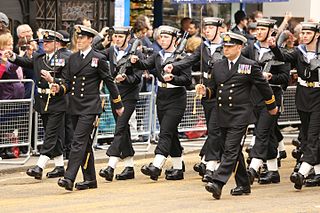
The uniforms of the Royal Navy have evolved gradually since the first uniform regulations for officers were issued in 1748. The predominant colours of Royal Navy uniforms are navy blue and white. Since reforms in 1997 male and female ratings have worn the same ceremonial uniform.

The following is a general overview of the Heer main uniforms, used by the German Army prior to and during World War II.
The uniforms of the United States Army distinguish soldiers from other service members. U.S. Army uniform designs have historically been influenced by British and French military traditions, as well as contemporary U.S. civilian fashion trends. The two primary uniforms of the modern U.S. Army are the Army Combat Uniform, used in operational environments, and the Army Green Service Uniform, worn during everyday professional wear and during formal and ceremonial occasions that do not warrant the wear of the more formal blue service uniform.

The Singapore Police Force has employed several different styles of uniforms throughout its history. Since 1969 it has used dark blue for its uniforms, although the first police uniforms introduced in 1856 were also in the same colour.
The military uniforms of the Union Army in the American Civil War were widely varied and, due to limitations on supply of wool and other materials, based on availability and cost of materials. The ideal uniform was prescribed as a dark blue coat with lighter pants, with a black hat. Officer's ranks were denoted with increasing levels of golden decoration. Specific jobs, companies, and units had markedly different styles at times, often following European customs such as that of the Zouaves. Officers uniforms tended to be highly customized and would stray from Army standard. Ironically, several main pieces of gear had been created by order of the U.S. War Secretary Jefferson Davis before the war; he later became Confederate President.
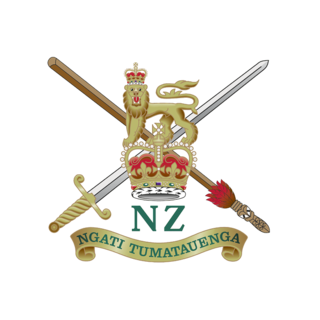
The New Zealand Army uniform has changed over the years from that of the original Armed Constabulary of the 1800s to the modern Army Combat Uniform style in use by the majority of world armies today. While British Army influence has always been strong, distinctive New Zealand features have gradually developed. From 2013 the New Zealand Army uniform underwent a complete redesign with a new and distinctive camouflage pattern unique to the NZDF.

The Uniforms of the Royal Danish Army distinguish soldiers from other service members. Royal Danish Army uniforms were originally influenced by French, Prussian and Russian military traditions. However, in more recent times, its uniforms have been characterized as being influenced by British uniforms, and, more significantly, American uniforms.





